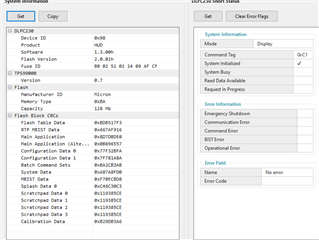Other Parts Discussed in Thread: DLPC230-Q1
sir i am new to DLP5530Q1EVM and just to perform outbox testing as per the instruction given in user guide i started it and it worked successfully for me but now i have some doubts which i have mentioned below and all these are with respect to video projection
1 how to set input video resolution its given in user guide "input video resolutions are programmed in the Extended Display Identification Data (EDID) EEPROM" so my doubt is how to program this EEPROM because the given supported resolution in user guide are not available on standard windows laptop ?
2 everything is controlled using DLPC230-Q1 Control Program Lite GUI so how to program this EVM from scratch as per our application requirement ?
3 how to get Image File (.bin) (default) so as to Reprogram the Onboard Flash Memory ?
4 is there any lecture or training available so as to learn more about this EVM


